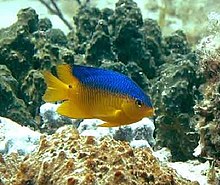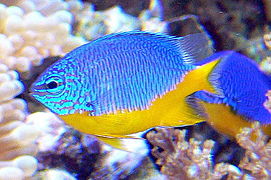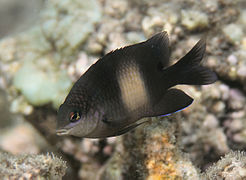Pomacentridae
| Clownfish and damselfish Temporal range:
| |
|---|---|

| |
| Cocoa damselfish, Stegastes variabilis | |
| Scientific classification | |
| Domain: | Eukaryota |
| Kingdom: | Animalia |
| Phylum: | Chordata |
| Class: | Actinopterygii |
| (unranked): | Ovalentaria |
| Family: | Pomacentridae Bonaparte, 1832[1] |
| Type species | |
| Pomacentrus pavo Bloch, 1787
| |
| Genera | |
|
See text | |
Pomacentridae is a
Around 385
The earliest known fossil damselfish is Chaychanus from the Early Paleocene of Chiapas, Mexico.[6]
Etymology
The name of the family is derived from the
Distribution and habitat
Pomacentrids are found primarily in tropical seas, with a few species occurring in subtropical waters (e.g., Hypsypops rubicundus). Most species are found on or near coral reefs in the Indo-West Pacific (from East Africa to Polynesia). The area from the Philippines to Australia hosts the greatest concentration of species.[7] The remaining species are found in the Atlantic or eastern Pacific.[citation needed] Some species are native to freshwater or brackish estuarine environments.[3][8]
Most members of the family live in shallow water, from 2 to 15 m (6 ft 7 in to 49 ft 3 in) in depth, although some species (e.g., Chromis abyssus) are found below 100 m (330 ft).[9] Most species are specialists, living in specific parts of the reef, such as sandy lagoons, steep reef slopes, or areas exposed to strong wave action. In general, the coral is used as shelter, and many species can only survive in its presence.[8]
The bottom-dwelling species are territorial, occupying and defending a portion of the reef, often centered on shelter. By keeping away other species of fish, some pomacentrids encourage the growth of thick mats of
Characteristics
Pomacentrids have an orbiculate to elongated body shape, which is often laterally compressed. They have interrupted or incomplete lateral lines and they usually have a single nostril on each side (some species of
They display a wide range of colors, predominantly bright shades of yellow, red, orange, and blue, although some are a relatively drab brown, black, or grey. The young are often a different, brighter color than adults.
Pomacentrids are

They also engage in symbiotic relationship with cleaner gobies of genus The anemone protects the clownfish while the clownfish rids parasites.
Lifecycle
Before breeding, the males clear an area of algae and invertebrates to create a nest. They engage in ritualised
The male guards the nest for the two to seven days needed for the eggs to hatch. The transparent
In captivity, pomacentrids live up to 18 years, but they probably do not live longer than 10 to 12 years in the wild.[8]
Genera
The 5th edition of Fishes of the World recognises 31 genera in three subfamilies in the family Pomacentridae:[2][13][1]
† means extinct
- Subfamily Chrominae Allen, 1975
- Acanthochromis Gill, 1863:
- Altrichthys Allen, 1999
- Azurina D.S. Jordan & McGregor, 1898
- Chromis Cuvier, 1814
- Dascyllus Cuvier, 1829
- Subfamily Lepidozyginae Allen, 1975
- Lepidozygus Günther, 1862
- Subfamily Pomacentrinae Bonaparte, 1831
- Abudefduf Fabricius, 1775
- Amblyglyphidodon Bleeker, 1877
- Amblypomacentrus Bleeker, 1877
- Amphiprion Bloch & Schneider, 1801
- Cheiloprion M.C.W. Weber, 1913
- Chrysiptera Swainson, 1839
- Dischistodus Gill, 1863
- HemiglyphidodonBleeker, 1877
- HypsypopsGill, 1861
- Mecaenichthys Whitley, 1929
- Microspathodon Günther, 1862
- Neoglyphidodon Allen, 1991
- NeopomacentrusAllen, 1975
- , 1903
- Parma Günther, 1862
- Plectroglyphidodon Fowler & Ball, 1824
- Pomacentrus Lacépède, 1802
- Pomachromis Allen & Randall, 1974
- PremnasCuvier, 1816
- Pristotis Rüppell, 1838
- Similiparma Hemsley, 1986
- Stegastes Jenyns, 1840
- Teixeirichthys J. L. B. Smith, 1953
- †Palaeopomacentrus Bellwood & Sorbini, 1996 [14]
Other authoritiies recognise 4 subfamilies and classify the family as follows:[13]
- Subfamily Chrominae
- Azurina
- Chromis
- Dascyllus
- Pycnochromis Fowler, 1941
- Subfamily Glyphisodontinae
- Abudefduf
- Subfamily Microspathodontinae
- Hypsypops
- Lepidozygus
- Mecaenichthys
- Microspathodon
- Nexilosus
- Parma (fish)|Parma
- Plectroglyphidodon
- Similiparma
- Stegastes
- Subfamily Pomacentrindeae
- Acanthochromis
- Altrichthys
- Amblyglyphidodon
- Amblypomacentrus
- Amphiprion
- Cheiloprion
- Chrysiptera
- Dischistodus
- Hemiglyphidodon
- Neoglyphidodon
- Neopomacentrus
- Pomacentrus
- Pomachromis
- Premnas
- Pristotis
- Teixeirichthys
- †Palaeopomacentrus
-
Abudefduf sexfasciatus
-
Acanthochromis polyacanthus
-
Dascyllus trimaculatus
-
Hypsypops rubicundus
-
Parma kermadecensis
-
Premnas biaculeatus
References
- ^ PMID 25543675.
- ^ ISBN 978-1-118-34233-6.
- ^ a b Jenkins, A.P. & G.R. Allen (2002). "Neopomacentrus aquadulcis, a new species of damselfish (Pomacentridae) from eastern Papua New Guinea". Records of the Western Australian Museum. 20: 379–382.
- ^ a b Froese, Rainer, and Daniel Pauly, eds. (2007). "Pomacentridae" in FishBase. July 2007 version.
- ISBN 978-0-87666-034-8.
- ISSN 0895-9811.
- ^ ISBN 978-0-471-25031-9.
- ^ ISBN 978-0-12-547665-2.
- doi:10.11646/zootaxa.1671.1.2.)
{{cite journal}}: CS1 maint: multiple names: authors list (link - S2CID 24134075.
- ^ "Amphiprion - Encyclopedia of Life". www.eol.org. Retrieved 2024-01-02.
- JSTOR 1445439.
- ^ a b Eschmeyer, William N.; Fricke, Ron & van der Laan, Richard (eds.). "Genera in the family Pomacentridae". Catalog of Fishes. California Academy of Sciences. Retrieved 2 October 2022.
- S2CID 84430386.
External links
- Froese, Rainer, and Daniel Pauly, eds. (2007). "Pomacentridae" in FishBase. January 2007 version.
- Smith, J.L.B. 1960. Coral fishes of the family Pomacentridae from the Western Indian Ocean and the Red Sea. Ichthyological Bulletin; No. 19. Department of Ichthyology, Rhodes University, Grahamstown, South Africa.
- Species inventory of Pomacentridae from New Caledonia.














